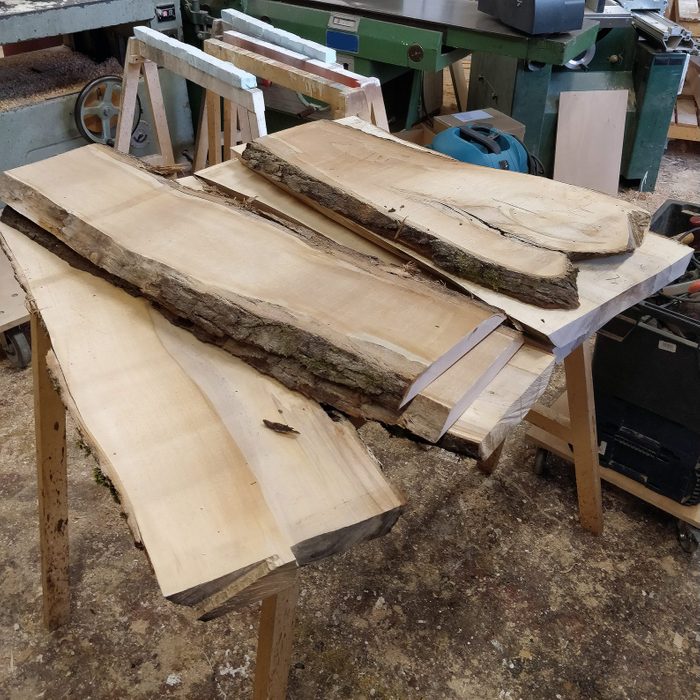Woodworking: What To Know About Maple Wood
Updated: Dec. 14, 2023

Wondering what you should know about maple wood before using it for a woodworking project? A pro woodworker gives his insights.
Maple is a unique wood amongst the American hardwoods. One of the hardest domestic timbers, yet it is reasonably easy to machine and consequently used in a huge variety of applications. It is sought out for its strength, stiffness and density. The wood also has some of the most beautiful figure in variations such as fiddleback, quilted or bird’s eye. I will walk you through everything you need to know about maple to give you the confidence to use it in your next woodworking project.
On This Page
What is Maple Wood?
Maple is a hardwood, meaning it comes from a deciduous tree (a tree that sheds its leaves each autumn) called the sugar maple. Its heartwood has a reddish brown color, while the sapwood can range from nearly white to cream and can have golden undertones. Maple is harvested specifically for its sapwood rather than its heartwood. It is reasonably easy to work with, although, due to its high density, it is more difficult to work with hand tools than most other domestics. It generally machines well and takes a finish nicely.
Types of Maple Wood
There are two main categories of maple trees:
- Sugar maple: In tree form, this timber is generally referred to as the sugar maple. It is the same plant from which we get most of our maple syrup. In wood form, however, it is referred to mostly as hard maple, or sometimes rock maple. It is among the most dense American domestic hardwoods, with a janka hardness rating of 1,450 lbf (pound-force). The Janka hardness rating comes from a test that measures the density of wood species. For context, cherry has a Janka rating of 950 lbf and white oak comes in at 1,360 lbf.
- Soft maple: Soft maple does not refer to a specific species of maple tree but rather a broad category of lumber that is not hard maple. In fact, most soft maple species are about half as dense as hard maple. The species of soft maple available for sale often depends on your locale. Here are two generally available species in the eastern and western states.
- Silver maple: Growing in the eastern U.S., silver maple has a lovely silvery undertone to the wood. I’ve had a few boards that have wide streaks of silver, almost resembling a vein of silver oar when finished! It is quite a bit softer than hard maple with a Janka rating of 750 lbf.
- Big leaf maple: Big leaf maple gets its name from its massive leaves, generally between six- and 12-inches wide. Growing in the coastal regions of the Pacific northwest, it is virtually the only commercially harvested maple species in the region. It is slightly denser than silver maple with a Janka rating of 850 lbf.
The Pros of Maple Wood
-
Availability: Maple is one of the most common commercially available woods in the U.S. and can be found at nearly all lumber suppliers, including big box stores.
-
Strength: Maple’s density and durability are among the highest for American hardwoods.
- Price: Maple is often moderately priced, it lies right in the middle of the pack for domestic hardwoods.
The Cons of Maple Wood
-
Staining: If you are one to use pigments on your wood, you may have a difficult time with hard maple. Due to its density and tight grain, it tends to take stains unevenly, and ends up looking blotchy. My simple solution is to not stain maple wood. Let the natural aging process beautify the wood.
- Density: Sure, rock maple earned its nickname by being wicked strong, but that density does make it slightly hard to work with.
What Is Maple Wood Used For?
Maple is used in a wide variety of applications, including:
-
Flooring: From homes to basketball courts and bowling alleys, maple is used for any floor that takes a beating;
-
Musical instruments: Maple is a favorite among luthiers (makers of stringed instruments) for its tight grain structure, resonance and visual beauty;
-
Baseball bats: In the last 20 to 30 years, maple has become the wood of choice for most bats used by Major League Baseball;
-
Woodworking: Let’s not forget the myriad uses maple has in the woodshop, from workbenches to jigs to furniture.
Maple Wood Cost and Purchasing
Hard maple is slightly more expensive than soft maple. Expect to pay anywhere from $8 to $12 per board foot, depending on the board width and grade. For highly figured variations like bird’s eye maple or quilted maple, prices go up to $20 to $30 per board foot. For comparison, most other furniture-grade domestic hardwoods cost anywhere from $5 to $15 per board foot.
